Having arrived back on The Isle of Man in mid December it was time to consider the Christmas festivities. Though we were on British territory, we opted to continue French tradition and hold a réveillon. A réveillon is a long dinner, and possibly a party, held on the evenings preceding Christmas Day or New Year’s Day. The name of the dinner is based on the word réveil (meaning “waking”), because participation involves staying awake until midnight and beyond. In the United States, the réveillon tradition is still observed in New Orleans due to the city’s strong French heritage, with a number of the city’s restaurants offering special réveillon menus on Christmas Eve.
 So, a couple of days before, armed with a a lump of wood and some parcel tape, I prepared the dining table for seven. This took a modicum of engineering skill since we don’t have a large dining room and the table was designed to only seat six! However, it seemed to work OK, because on 24th Marie-Danielle prepared a beautiful table for us while I was locked away in the kitchen!
So, a couple of days before, armed with a a lump of wood and some parcel tape, I prepared the dining table for seven. This took a modicum of engineering skill since we don’t have a large dining room and the table was designed to only seat six! However, it seemed to work OK, because on 24th Marie-Danielle prepared a beautiful table for us while I was locked away in the kitchen!
Our guests were Penny and Sarah who had met us in Paris at Le Procop, Penny’s husband Steve, and Jill and Bruno who are, like us, a French-British couple only the other way round (Bruno is French and Jill is British). We weren’t sure if 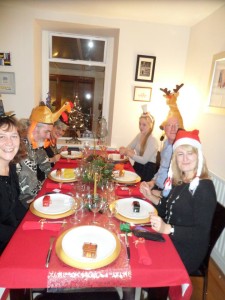 Bruno was going to make it since he had been unwell for some days. However, he made a huge effort and spent the evening with a “cockerel hat” perched on his head (as opposed to Steve, who wore a “reindeer hat”) – yes, it was one of those nights! We are certainly blessed with some wonderful friends.
Bruno was going to make it since he had been unwell for some days. However, he made a huge effort and spent the evening with a “cockerel hat” perched on his head (as opposed to Steve, who wore a “reindeer hat”) – yes, it was one of those nights! We are certainly blessed with some wonderful friends.
So, the menu!
First off, since it was Christmas, as part of the apperitifs, we constructed a “Christmas wreath” out of little cocktail sausages and that buttery, flaky, Vienna-style pastry used to make croissants. The bow itself was a red pepper that underwent M-D’s surgical skills and the bowl in the middle held Dijon mustard for dipping. 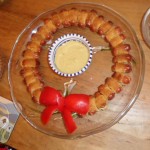 Along with quails eggs, olives, “appericubes” (baby cheese cubes from France), cocktail biscuits and a couple of bottles of chilled Cremant d’Alsace, we passed a pleasant half-hour awaiting the main event. Or should I say that “they” passed a pleasant half-hour awaiting the main event, since I was locked away in the kitchen having all sorts of fun on my own!
Along with quails eggs, olives, “appericubes” (baby cheese cubes from France), cocktail biscuits and a couple of bottles of chilled Cremant d’Alsace, we passed a pleasant half-hour awaiting the main event. Or should I say that “they” passed a pleasant half-hour awaiting the main event, since I was locked away in the kitchen having all sorts of fun on my own!
As a starter, we had decided on Salade des Gourmets, that wonderful salad with lots of added extras like foie gras, smoked salmon, magret de canard, small cherry tomatoes, fresh scallops and prawns. It makes me salivate just thinking about it!
And then came the awkward bit!!!
 We decided to do a Beef Wellington which normally (for a decent size fillet of beef) takes about 35-40 minutes to cook. However, I knew that most of our guests would prefer their meat more cooked than M-D and I normally eat it, so I had to allow extra cooking time. To be sure, I used a cook’s thermometer and aimed to get to 60ºC (140ºF), where normally we go to about 54ºC (130ºF), I had estimated an additional 10 minutes but it took nearer 20 minutes extra. Normally that wouldn’t be too critical since everybody just chats and the time passes. However, Penny had committed to ringing the bells at the cathedral for the midnight service, so had to leave the house at about 11:40pm. Fortunately, we just scraped in and she was able to finish her plate of Beef Wellington, Champ and mixed vegetables before having to leave.
We decided to do a Beef Wellington which normally (for a decent size fillet of beef) takes about 35-40 minutes to cook. However, I knew that most of our guests would prefer their meat more cooked than M-D and I normally eat it, so I had to allow extra cooking time. To be sure, I used a cook’s thermometer and aimed to get to 60ºC (140ºF), where normally we go to about 54ºC (130ºF), I had estimated an additional 10 minutes but it took nearer 20 minutes extra. Normally that wouldn’t be too critical since everybody just chats and the time passes. However, Penny had committed to ringing the bells at the cathedral for the midnight service, so had to leave the house at about 11:40pm. Fortunately, we just scraped in and she was able to finish her plate of Beef Wellington, Champ and mixed vegetables before having to leave.
Jill, meanwhile, is not a meat eater (if the beast had more than 2 legs while it was alive) but she does enjoy Confit de Canard, so I made her a “Confit Parmentier” which is sort of French for shepherds pie using duck instead of lamb!! I simply heated and shredded a duck confit, placed it in a ramekin along with a little chicken stock then covered it with mashed potato (which I was making anyway for the champ!).
While Penny rang her bells (which we could hear since the cathedral is only a couple of hundred yards away) we all finished our main course and took a breather. Well, a sort of breather! In fact we had a “Trou Normand” (literally, a Norman hole) which, traditionally, is Eau-de-vie, especially calvados, served as a middle course in a large meal in the traditional belief it restores appetite. The first time I came across this was a hotel in Normandy where we styayed for a New Year once. In the middle of the meal, the waiter served us all an apple sorbet and then arrived with a teapot!! Tea it was not! Calvados it most certainly was. So, sure enough, we served a sorbet with calvados then sat with contented smiles on our faces waiting for Penny’s return.
 Upon Penny’s return, just before midnight, we all exchanged presents (I did warn you we were doing things French style!). After which, cheese was served, followed by M-D’s famous Chocolate and Walnut Gateau (dutifully decorated with Santa and a snowman!)
Upon Penny’s return, just before midnight, we all exchanged presents (I did warn you we were doing things French style!). After which, cheese was served, followed by M-D’s famous Chocolate and Walnut Gateau (dutifully decorated with Santa and a snowman!)
And what, you might ask, did we drink with this meal? Well, it may surprise you to know that we stayed with Bordeaux Origami from start right through till finish. It’s made by Famille Capdevielle and is 80% Merlot and 20% Cabernet Franc so is quite light for a red. For this reason it worked through all four courses. All said, a very pleasant evening with some valued friends. Now we have New Year’s Eve to look forward to!!
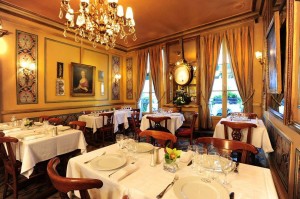 First of all, though, there was some other business to attend to! in early December we enjoyed a really pleasant evening with Penny and Sarah, friends from the Isle of Man who were visiting Paris. We ate at “Le Procope” in Paris. Founded in 1686 and now Paris’ oldest café, there’s a great atmosphere. The food is excellent and reasonably priced (for central Paris). I tried a Tête de Veau (veal’s head) which, for some reason, I’ve always avoided till now. Frankly, I shall carry on avoiding it!
First of all, though, there was some other business to attend to! in early December we enjoyed a really pleasant evening with Penny and Sarah, friends from the Isle of Man who were visiting Paris. We ate at “Le Procope” in Paris. Founded in 1686 and now Paris’ oldest café, there’s a great atmosphere. The food is excellent and reasonably priced (for central Paris). I tried a Tête de Veau (veal’s head) which, for some reason, I’ve always avoided till now. Frankly, I shall carry on avoiding it!  There was nothing wrong with the food or the way it had been prepared it’s just that some foods suit us and some don’t. Tête de Veau turned out to just not be my thing. The other three hit luckier than me with dishes that suited them and that they enjoyed. But I had the pleasure of the company of three charming ladies, so I’m not complaining! The evening was fun and it was great to meet friends in a different environment.
There was nothing wrong with the food or the way it had been prepared it’s just that some foods suit us and some don’t. Tête de Veau turned out to just not be my thing. The other three hit luckier than me with dishes that suited them and that they enjoyed. But I had the pleasure of the company of three charming ladies, so I’m not complaining! The evening was fun and it was great to meet friends in a different environment. And talking of Penny and Sarah, we will have pleasure of their company on December 24th for our Christmas celebration. But more of that when it happens because first we celebrated an early Christmas with M-D’s family near Orléans in north-central France. As our childrens’ families mature, we see less of them than before and, to me, this is quite right. They have built their own lives and we are now only a small part of it. So, since Muriel, Vincent and ‘the girls’ were heading to Corsica for Christmas, we spent an evening with them and had an early festive celebration.
And talking of Penny and Sarah, we will have pleasure of their company on December 24th for our Christmas celebration. But more of that when it happens because first we celebrated an early Christmas with M-D’s family near Orléans in north-central France. As our childrens’ families mature, we see less of them than before and, to me, this is quite right. They have built their own lives and we are now only a small part of it. So, since Muriel, Vincent and ‘the girls’ were heading to Corsica for Christmas, we spent an evening with them and had an early festive celebration. Of all the kitchen nightmares the cook has to live with, the one that generates the most problems for many is the peeling and chopping of onions, and the associated tears and stinging eyes.
Of all the kitchen nightmares the cook has to live with, the one that generates the most problems for many is the peeling and chopping of onions, and the associated tears and stinging eyes. I’ve only tried a few of these tips myself, but one I hadn’t read about was this intriguing tip, which suggests that you to hold a piece of bread in your mouth as you chop. But it has to be pain au levain. Pain levain is a leavened bread, or sour dough bread. That is to say a mixture of water and flour where a culture of yeast and lactic acid bacteria develops. This fermentation, releases carbon dioxide and allows the dough to rise.
I’ve only tried a few of these tips myself, but one I hadn’t read about was this intriguing tip, which suggests that you to hold a piece of bread in your mouth as you chop. But it has to be pain au levain. Pain levain is a leavened bread, or sour dough bread. That is to say a mixture of water and flour where a culture of yeast and lactic acid bacteria develops. This fermentation, releases carbon dioxide and allows the dough to rise. I headed back to the Isle of Man on my own towards the end of June because I had some work to do in our bedroom, so it was easier having the place to myself and not disrupting Marie-Danielle too. When we bought the house on the island, the builder who had renovated it had generally done a good job but, on a couple of things, he had taken shortcuts. One of these shortcuts was that there was water penetration on the top storey and damp was coming through the walls into our bedroom. The builder had tried to hide this by adding a couple of false stud walls with a 4″ (100mm) gap to the outside wall. Naturally, this was just a short-term cover-up and, In August last year (2013) we had scaffolding erected and roofers arrived to resolve the situation. So now it was time to rip out the false wall and let the original wall breathe.
I headed back to the Isle of Man on my own towards the end of June because I had some work to do in our bedroom, so it was easier having the place to myself and not disrupting Marie-Danielle too. When we bought the house on the island, the builder who had renovated it had generally done a good job but, on a couple of things, he had taken shortcuts. One of these shortcuts was that there was water penetration on the top storey and damp was coming through the walls into our bedroom. The builder had tried to hide this by adding a couple of false stud walls with a 4″ (100mm) gap to the outside wall. Naturally, this was just a short-term cover-up and, In August last year (2013) we had scaffolding erected and roofers arrived to resolve the situation. So now it was time to rip out the false wall and let the original wall breathe.
 While Christine was over, we did a few walks and a bit of casual sightseeing. The location in the photo on the left is in the south of the island and, on that day, we could clearly see Scotland, England, Wales and Ireland from that spot. It makes you realise how central The Isle of Man is in the British Isles and Ireland.
While Christine was over, we did a few walks and a bit of casual sightseeing. The location in the photo on the left is in the south of the island and, on that day, we could clearly see Scotland, England, Wales and Ireland from that spot. It makes you realise how central The Isle of Man is in the British Isles and Ireland. Then, in August, we housed a couple of French visitors for a week. Twice a year, the Isle of Man becomes home to bikers from all over the world. In June, they come for the Isle of Man TT and in August they come for the Isle of Man Festival of Motorcycling (used to be called The Manx Grand Prix). During thoise times, the population of the island doubles so, local people help out by offering rooms to bikers at a sensible price. It’s fun and it helps the island economy.
Then, in August, we housed a couple of French visitors for a week. Twice a year, the Isle of Man becomes home to bikers from all over the world. In June, they come for the Isle of Man TT and in August they come for the Isle of Man Festival of Motorcycling (used to be called The Manx Grand Prix). During thoise times, the population of the island doubles so, local people help out by offering rooms to bikers at a sensible price. It’s fun and it helps the island economy. We got to meet and greet Mimie Champseix-Léonard and her husband, Serge. A real nice couple from Tarnac in the Limousin region of France. Though they seemed to enjoy exploring the various watering holes on the island, I think they were quite pleased when we asked them to have dinner with us on their final night before heading back to France!
We got to meet and greet Mimie Champseix-Léonard and her husband, Serge. A real nice couple from Tarnac in the Limousin region of France. Though they seemed to enjoy exploring the various watering holes on the island, I think they were quite pleased when we asked them to have dinner with us on their final night before heading back to France! Last night we hosted a little dinner with some friends who have eaten with us before. It was actually a bit like an unofficial meeting of the conseil syndical de copropriété (the elected committee that help administer the day-to-day running of the apartment buildings). The conseil syndical ensures that lightbulbs are replaced, graffitti is painted over, cleaning is done properly, lifts work, doors and locks are maintained, and other stuff like that. They are elected each year at an AGM of all the owners and last night we had Yvon, Louis and M-D who are already on this committee, Pascale who is putting herself forward for election this year, Louis’ lovely wife, Monique, and of course, myself. So after a short spell on the balcony looking across the whole résidence (photo above), and then an aperitif in comfy chairs, we settled in for some serious eating!
Last night we hosted a little dinner with some friends who have eaten with us before. It was actually a bit like an unofficial meeting of the conseil syndical de copropriété (the elected committee that help administer the day-to-day running of the apartment buildings). The conseil syndical ensures that lightbulbs are replaced, graffitti is painted over, cleaning is done properly, lifts work, doors and locks are maintained, and other stuff like that. They are elected each year at an AGM of all the owners and last night we had Yvon, Louis and M-D who are already on this committee, Pascale who is putting herself forward for election this year, Louis’ lovely wife, Monique, and of course, myself. So after a short spell on the balcony looking across the whole résidence (photo above), and then an aperitif in comfy chairs, we settled in for some serious eating! Starter was nice and simple – foie gras and roulades de Jambon au foie de canard en gelée au sauternes. And if you are wondering what that is, it’s foie gras rolled in ham which we get from
Starter was nice and simple – foie gras and roulades de Jambon au foie de canard en gelée au sauternes. And if you are wondering what that is, it’s foie gras rolled in ham which we get from  Main course was a repeat of something we have done before (for other people),
Main course was a repeat of something we have done before (for other people),  After a course of cheese and salad, for dessert, we served another of our old favourites,
After a course of cheese and salad, for dessert, we served another of our old favourites,  So to walk it all off, M-D and I went for an afternoon ‘constitutional’ along the river Seine this afternoon. The massive locks there are for the big barges that use the river (some of them up to 100m long) for moving mostly sand and shingle. It’s fascinating watching them manoeuvre into the locks which have a height difference of about 4 metres at this point.
So to walk it all off, M-D and I went for an afternoon ‘constitutional’ along the river Seine this afternoon. The massive locks there are for the big barges that use the river (some of them up to 100m long) for moving mostly sand and shingle. It’s fascinating watching them manoeuvre into the locks which have a height difference of about 4 metres at this point.  While walking, I spotted a brightly-coloured wood nymph! (see left).
While walking, I spotted a brightly-coloured wood nymph! (see left). Of course, your fishmonger will open your scallops for you. In fact, they mostly sell just the flesh. But there is seriously nothing better than a FRESH scallop, as we discovered the other day as we went to the market. Most people are simply afraid of what’s inside a scallop and are not sure what to keep and what to throw away, but it’s drop-dead simple, and here’s how you do it…
Of course, your fishmonger will open your scallops for you. In fact, they mostly sell just the flesh. But there is seriously nothing better than a FRESH scallop, as we discovered the other day as we went to the market. Most people are simply afraid of what’s inside a scallop and are not sure what to keep and what to throw away, but it’s drop-dead simple, and here’s how you do it… You will now be left with just the edible muscle, though it may be a little gritty with sand, which you can easily rinse off under cold running water. Now you are free to eat them raw from the shell or create any one of a dozen delicious recipes like my favourite,
You will now be left with just the edible muscle, though it may be a little gritty with sand, which you can easily rinse off under cold running water. Now you are free to eat them raw from the shell or create any one of a dozen delicious recipes like my favourite,  At the weekend, we went up to Lille, where Christine lives and she trumped our Grenadin de Veau Gratiné with Magre de Canard (it’s not really a question of trying to outdo each other, because both recipes are drop-dead simple). Magre de Canard is duck breast – nothing more and nothing less. However, Christine roasted it and served it with a green pepper sauce and accompanied by sautée potatoes. It was more than splendid, it was rapture on a plate (and I ate far more than I should!)
At the weekend, we went up to Lille, where Christine lives and she trumped our Grenadin de Veau Gratiné with Magre de Canard (it’s not really a question of trying to outdo each other, because both recipes are drop-dead simple). Magre de Canard is duck breast – nothing more and nothing less. However, Christine roasted it and served it with a green pepper sauce and accompanied by sautée potatoes. It was more than splendid, it was rapture on a plate (and I ate far more than I should!) While we were in Lille, we visited the Roubaix swimming pool museum. This is the most amazing place, and has made use of a beautiful old Art Deco swimming pool that was due for demolition due to safety problems.
While we were in Lille, we visited the Roubaix swimming pool museum. This is the most amazing place, and has made use of a beautiful old Art Deco swimming pool that was due for demolition due to safety problems. To cut a long story short, we had a long “apperitif” with Jean-Louis and France while we waited for Christine, and then sat down to eat just before 3pm! Fortunately, the
To cut a long story short, we had a long “apperitif” with Jean-Louis and France while we waited for Christine, and then sat down to eat just before 3pm! Fortunately, the 
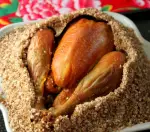
 By way of marking our return to France, we invited our friends and neighbours, Terry, Julie, Dominic and Kate to dinner last night. We kicked off in normal style with a glass or two of Kir, using a rather nice Chardonny that had travelled back with us in January. When we settled at the table, we started with
By way of marking our return to France, we invited our friends and neighbours, Terry, Julie, Dominic and Kate to dinner last night. We kicked off in normal style with a glass or two of Kir, using a rather nice Chardonny that had travelled back with us in January. When we settled at the table, we started with  After which, we resorted to one of our regular favourites,
After which, we resorted to one of our regular favourites,  Our dessert was a chocolate and nut gateau that M-D had made using walnuts from her daughter’s garden in The Loire region of France. We served this with orange slices sprinked with orange zest that had been cooked in cinnamon sugar and, just to give a contrast, we mixed normal oranges and blood oranges as we arranged them on the plate. Naturally, there being plenty of chocolate in the cake, we served Mas Amiel with its dense and concentrated inky black Grenache grapes and its complex nose of tobacco and garden herbs.
Our dessert was a chocolate and nut gateau that M-D had made using walnuts from her daughter’s garden in The Loire region of France. We served this with orange slices sprinked with orange zest that had been cooked in cinnamon sugar and, just to give a contrast, we mixed normal oranges and blood oranges as we arranged them on the plate. Naturally, there being plenty of chocolate in the cake, we served Mas Amiel with its dense and concentrated inky black Grenache grapes and its complex nose of tobacco and garden herbs. White wine with Crême de Cassis is known as “Kir” in France and is a popular apéritif drink named after Félix Kir (1876–1968), mayor of Dijon in Burgundy, who popularized the drink by offering it at receptions to visiting delegations. Besides treating his international guests well, he was also promoting two vital economic products of the region – blackcurrants and white wine.
White wine with Crême de Cassis is known as “Kir” in France and is a popular apéritif drink named after Félix Kir (1876–1968), mayor of Dijon in Burgundy, who popularized the drink by offering it at receptions to visiting delegations. Besides treating his international guests well, he was also promoting two vital economic products of the region – blackcurrants and white wine.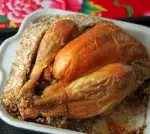 The main course was the “salty” end of the recipe with
The main course was the “salty” end of the recipe with